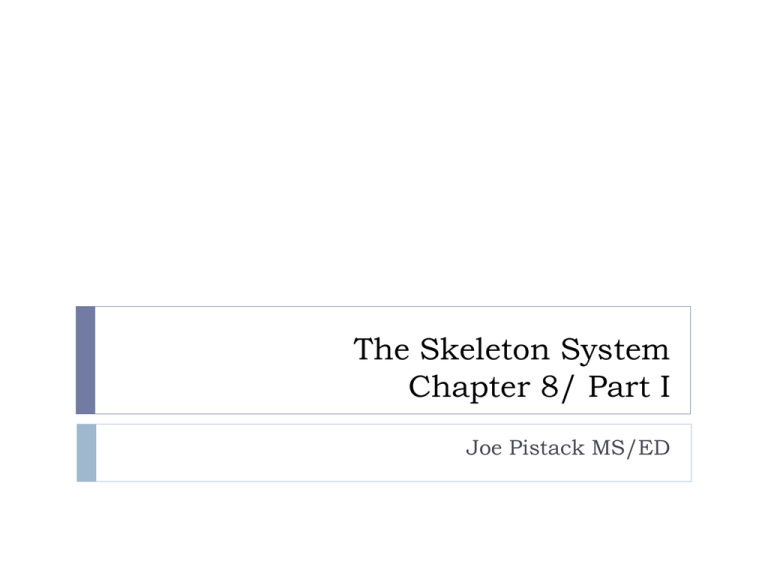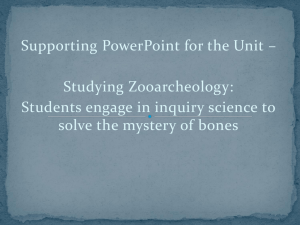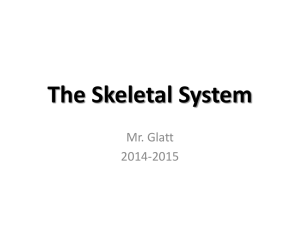
The Skeleton System
Chapter 8/ Part I
Joe Pistack MS/ED
The Skeletal System
The Skeletal System
Consists of:
Bones
Joints
Cartilage
Ligaments
The skeletal system consists of 206 bones.
The Skeletal System
Functions:
Bones of the lower extremities support the
weight of the body.
Support and protect the soft body organs.
Enables the body to move about.
Store a number of minerals, calcium and
phosphorus are most important.
Red bone marrow produces blood cells.
Classification of Bones
Bones are classified as follows:
Long bones-longer than they are wide. Found in the arms
and legs.
Classification of Bones
Short Bones-shaped like cubes and are found primarily in
the wrists and ankles.
Classification of Bones
Flat Bones-thin, flat, curved. Form the ribs, breastbone and
skull.
Classification of Bones
Irregular Bones-differently shaped, not classified as long ,
short, or flat. Include hip bones, vertebrae, and various
bones in the skull.
Tissue and Bone Formation
Osseous tissue-another word for bone.
Osteocytes-bone cells.
- secrete an intercellular matrix.
-contain calcium, minerals and protein
fibers.
Two Types of Bone
Compact BoneDense hard bone.
Found in shafts of long
bones and outer surfaces
of other bones.
Two Types of Bone
Spongy BoneAlso called cancellous
bone.
Less dense
Found at the ends of long
bones and in the center of
other bones.
Compact Bone
Microscopically-compact bone and spongy bone look
different.
Compact bone is tightly packed, density gives it strength.
Osteon or haversion system-microscopic unit of compact
bone.
Each haversion system consists of mature osteocytes
arranged in concentric circles around large blood vessels.
Compact Bone
Area surrounding the osteocytes is filled with protein fibers,
calcium and other minerals.
Protein fibers provide elasticity.
Minerals make bone tissue hard and strong.
Compact bone consists of many haversian systems running
parallel to each other, system looks like a long cylinder.
Blood vessels run laterally to the haversian system, this
ensures adequate blood supply to the bone tissue.
Compact Bone
Spongy Bone
Also called cancellous bone.
Does not have a haversian canal.
Bone tissue is arranged in plates called trabeculae.
Bony plates are separated by holes that give it a punchedout “swiss cheese” appearance.
Holes are important for: (1)decrease the weight of bone,
make it lighter, and (2)contain red bone marrow.
Spongy Bone
Red bone marrow richly supplies the spongy bone with
blood cells for use throughout the body.
Spongy bone is located in short, flat, and irregular bones.
Spongy bone is found in the ends of long bones.
Long Bone
Made up of an
arrangement of compact
and spongy tissue, which
accounts for its strength.
Contains sites of growth
and reshaping and
structures associated with
joints.
Long Bone
Parts of a long bone:
Diaphysis-long shaft of the
bone, composed primarily of
compact bone, therefore it
provides strength.
Epiphysis-enlarged ends of
the long bone. Articulates
or meets with a second
bone at a joint. Consists of
a thin layer of compact bone
overlying spongy bone.
Epiphysis are covered with
cartilage.
Long Bone
Epiphyseal disc-band of
hyaline cartilage located at
each end, between the
epiphysis and the diaphysis in
a growing bone. This band
of cartilage is the epiphyseal
disc or growth plate.
Medullary cavity-hollow
center of the diaphysis. The
inside is lined with
connective tissue called the
endosteum.
Long bone
Periosteum-tough, fibrous
connective tissue membrane
that covers the outside of
the diaphysis.
Anchored firmly to the
outside of bone on all
surfaces except articular
cartilage.
Periosteum protects bone,
serves as a point of
attachment for muscle,
contains blood vessels that
nourish underlying bone.
Long Bone
Injury to the periosteum
may have serious
consequences to the
health of the bone since
this structure carries the
blood supply.
Articular Cartilage-found on
the outer surface of the
epiphysis, forms a smooth
shiny surface that
decreases friction within a
joint.
Ossification
Ossification-the formation of bone.
Occurs differently in flat and long bones.
In the fetus, flat bones in the skull consist of thin connective tissue
membrane.
Ossification begins when the osteoblasts (bone forming cells),
migrate to the region of the flat bones.
The osteoblasts secrete calcium and other minerals into the spaces
between the membranes, thereby forming bone.
This process involves the replacement of thin membrane with bone.
Ossification of Long Bones
Ossification of long bones occurs as bone tissue replaces
cartilage.
The fetal skeleton is composed largely of cartilage.
As the baby matures, osteoblasts invade the cartilage and
gradually replace it with bone until all but the articular
cartilage and the epiphyseal disc have been replaced by
bone.
Isolated pieces of cartilage, such as the bridge of the nose
and parts of the ribs remain.
Ossification
Growing Bones
Two types of bone growth occurs from infancy to adulthood.
(1)Longitudinally-determines the height of an individual.
(2)Thicker & wider-to support the weight of the adult.
Longitudinally-bone grows at the epiphyseal disc, (also called the growth
plate).
Cartilage adjacent to the epiphysis continues to multiply and grow toward
the diaphysis.
Cartilage next to the diaphysis is invaded by osteoblasts and become
ossified.
As long as the cartilage continues to form within the epiphyseal disc, the
bone will continue to lengthen.
Growing Bones
Longitudinal bone growth ceases when the epiphyseal
disc becomes ossified and fused.
Growth hormone stimulates growth at the epiphyseal
disc, making the child taller.
The sex hormones estrogen and testosterone cause the
epiphyseal disc to fuse, inhibiting further longitudinal
growth.
The epiphyseal disc is more sensitive to estrogen, this
causes girls to tend to be shorter than boys.
Growing Bones
Longitudinal growth generally ceases after puberty.
Injury to the epiphyseal disc may impair longitudinal bone
growth. Eg. Injured leg shorter than uninjured leg.
Giantism- hypersecretion of growth hormone.
Dwarfism- undersecretion of growth hormone.
Growth Hormone Abnormalities
Giantism
Dwarfism
Growing Thicker and Wider
After longitudinal bone growth ceases, bones continue to
increase in thickness and width.
Bones are continuously being reshaped.
Bone reshaping is accomplished by a combination of the
actions of osteoblasts and osteoclasts.
Osteoblasts- bone forming cells.
Osteoclasts- bone destroying cells.
Growing Bones
Osteoblastic Activity: While osteoblasts build new bone,
osteoclasts, found on the inner bone surface break down
bone tissue, thereby hollowing out the interior of the
bone.
Osteoclastic Activity is like sculpting, the bricklayer lays the
bricks and the sculptor will hollow out the middle so that
it is not too heavy.
Bone resorption-(not reabsorption)-process whereby
osteoclasts breakdown bone matrix.
Growing Bones
Bone resorption- widens the bone, moves calcium from the
bone to the blood.
Bone resorption plays a crucial role in blood calcium levels.
Weight-bearing – factor that stimulates bone growth.
Exercise and weight bearing keep calcium in the bone and
increase bone mass.
Bedridden and sedentary people tend to lose bone mass
causing bones to be easily broken when stressed.
Surface Markings
Surface of bones appears
bumpy and irregular.
Appearance is due to
numerous ridges,
projections, depressions, and
grooves called bone surface
markings.
These bone surface
markings serve as points of
attachment for muscles,
tendons and ligaments.
Condyle
Condyle- large rounded
knob that usually
articulates with another
bone.
Epicondyle
Epicondyle- an enlargement
near or above a condyle.
Bone Markings
Head- an enlarged and
rounded end of a bone.
Bone Markings
Facet- a small flattened
surface.
Bone Markings
Crest- a ridge on a bone
Bone Markings
Process-a prominent
projection on a bone.
Bone Markings
Spine- sharp projection.
Bone Markings
Tubercle (tuberosity)- a
knoblike projection.
Bone Markings
Trochantor- a large
(tuberosity) found only on
the femur.
Bone Markings
Depressions/Openings
Foramen- an opening through
a bone, usually serves as a
passageway for nerves,
blood vessels, and
ligaments.
Bone Markings
Fossa- a depression or
groove.
Bone Markings
Meatus-a tunnel or tubelike
passageway.
Bone Markings
Sinus-a cavity or hollow
space.
Fractures
Fractures- break in the bone.
Simple Fracture- a break in which the overlying skin
remains intact. Local tissue damage is minimal.
Compound Fracture- a broken bone that also pierced the
skin. Ends of the broken bone usually cause extensive
tissue damage.
Incomplete Fracture- (greenstick)-usually occurs in children,
the break is incomplete because the child’s bone is still
made up of some cartilaginous material.
Common Types of Fractures








